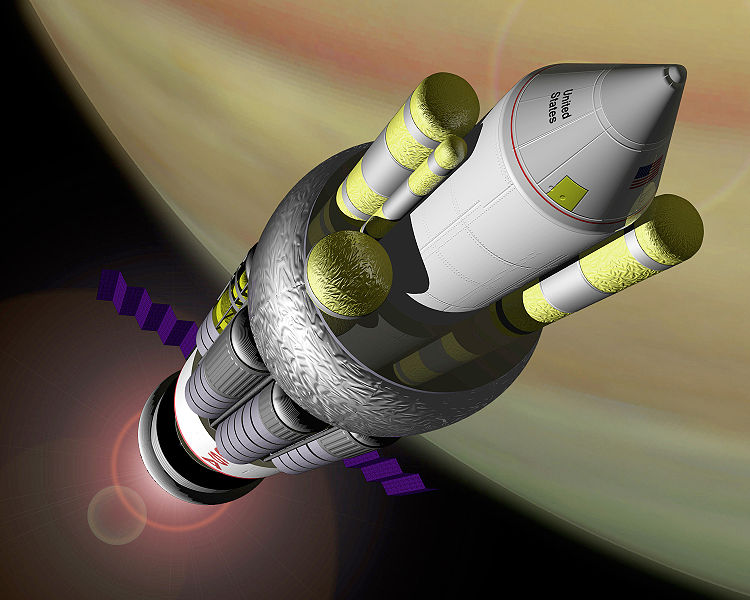 |
| Deep Space 1 - first spacecraft to use Ion Drive |
Ion drive is a propusion system that emits ions. It uses an inert gas and voltage differentials to accelerate the gas. The result is that it takes a long time to get to the destination, but its cheaper than large conventional chemical rockets to get up to speed. Deep Space 1 got to fly around the southern pole of the Sun and Smart-1 got to go from Earth orbit to Lunar orbit on ion thrusters. Dawn got to Vesta and then to Ceres. It could only accomplish visiting two space bodies with an on board main thruster such as the ion drive to escape the orbit of one and insert into the orbit of another. It's like scampering around the asteroid belt. I hope it finds its cheese.
Thermal nuclear propulsion system is one that emits matter heated by a thermal nuclear reactor. We're talking a rocket here. Well, the idea is that energy in the form of heat from a nuclear reactor can heat up a gas and produce really fast speeds for a spacecraft. That could be a potentially good propulsion system. OK, let's see. In the wiki it mentions thermal nuclear reactor and hydrogen in the first sentence. It also mentions that a core was made in 1955. I don't know what they were smoking in 1955, but it must have been good stuff. What do you tell the first guy that's going to fly this thing?
"Here you go buddy, just plant your seat right there and strap in. Concerns? Nah, we don't expect anything to go wrong. It will be a fun ride. Here, just sign on the dotted line right here. Small print? Don't let it concern you, it's just some legal mumbo jumbo and all. Have a safe trip."
Who in their right mind would fly this? I don't think the human psyche can dismiss images of a big explosion when talking about nuclear reactor and hydrogen together. Dr. Zubrin wants NASA to research this. I hope a working model would be indeed safe.
 Let's talk about the big one, nuclear pulse propulsion studied under the name of Project Orion. Essentially, its thermal nuclear explosions detonated just behind a very thick pusher plate. Do this several times and the craft accelerates in pulse intervals. It's funny that the scientists were talking about making a farm on a spacecraft that uses this propulsion. The energy this thing can harness is enormous. It's the largest energy per weight that we know of. The scientists involved do agree that there were some issues with the system to be worked out. The basic idea works, and was tested on small scale with conventional explosives. Now, it's pulse propulsion. That means one minute your all fine and dandy and the next your splattered against the back bulkhead until the acceleration stops. Then it starts all over again. How uncomfortable does this seem? Can you imagine a cow handling this? You'll probably end up with sour milk. In spite of the challenges of this system, the scientists were optimistic about making a viable system.
Let's talk about the big one, nuclear pulse propulsion studied under the name of Project Orion. Essentially, its thermal nuclear explosions detonated just behind a very thick pusher plate. Do this several times and the craft accelerates in pulse intervals. It's funny that the scientists were talking about making a farm on a spacecraft that uses this propulsion. The energy this thing can harness is enormous. It's the largest energy per weight that we know of. The scientists involved do agree that there were some issues with the system to be worked out. The basic idea works, and was tested on small scale with conventional explosives. Now, it's pulse propulsion. That means one minute your all fine and dandy and the next your splattered against the back bulkhead until the acceleration stops. Then it starts all over again. How uncomfortable does this seem? Can you imagine a cow handling this? You'll probably end up with sour milk. In spite of the challenges of this system, the scientists were optimistic about making a viable system.Light Pulse propulsion is a modern idea that has some relation with nuclear pulse propulsion. The idea is that while in atmosphere, a laser can give a reflector with a particular shape power to heat up air and make it expand thus propelling the craft. The laser is shot form the ground. This is to propel a craft from the ground to orbit as a first stage. It's a compelling idea, because you have your power source on the ground and not as dead weight on the craft. If you use a dedicated nuclear power facility with a very large laser, then you can lift a lot of stuff and many craft to orbit reducing the cost of launch over time. I like this idea. I wonder if it can roast some marshmallows in flight. The in-flight meal should have s'mores in it.
Well, that's what Dr. Zubrin was talking about, and more. We get weird ideas about how to travel from point A to point B. Most don't work. We keep trying until we get it right. You can get your idea a try if you study Math and Science. Your going to have to learn to write and argue as well, because your going to get criticized. Are you up for the challenge?
[NOTE FROM THE AUTHOR: The humor in this post is and experiment. In no way was the intention to criticize. I'm sorry if it comes off that way. I'm keeping the post as is as a reminder of how poorly chosen humor can hurt.]
